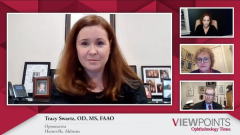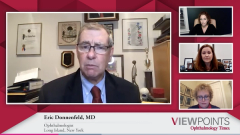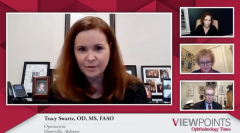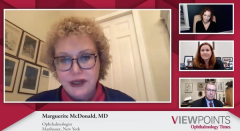
Diagnosis and overlooking asymptomatic patients with dry eye
Episodes in this series

Marguerite McDonald, MD: What is the diagnostic process for identifying dry eye disease? What is your approach to screening for it?
Eric Donnenfeld, MD: That’s a great question. A lot of things are involved, and a lot of tests are available. I like to take a pragmatic approach to dry eye, and it starts by listening to the patient and hearing what they have to say. Sometimes just listening to their symptoms will give you a lot of information. It speaks volumes about my personality, but I have a favorite symptom, and my favorite symptom is fluctuating vision. When a patient’s vision fluctuates, it’s almost always because of ocular surface disease. It could be vision changing between blinks. It could be vision on the computer getting blurry after half an hour. It could be that my vision is good in the morning but gets bad in the afternoon. It starts there.
Then the next part is the actual physical exam. It’s really important to look at the eyelids. A lot of times eye care professionals just don’t look at the lids. They go right to the eye and look at the eye itself. They look at the lid margin, for meibomian gland disease. At least 75% of dry eye is due to meibomian gland disease. Then we can start with the actual tear film diagnostics. The tests I like to do are predicated on patients walking into the office with a questionnaire that’s done. The questionnaire is administered by my staff to every patient who comes into the practice, and that questionnaire asks for some very specific questions about dry eye disease. If they answer positively, then it empowers my technicians to do the appropriate testing. I like to do osmolarity, sometimes we do MMP9. I like topography as well because it gives me a lot of information about the quality of the tear film.
Then the patient comes to see me. My partner Hank Perry made me a convert. I like lissamine green staining. It’s very helpful to look at conjunctival staining. I like tear breakup time. I don’t really look at osmolarity as much anymore, unless I’m thinking someone has rheumatoid-related dry eye disease and their Schirmer’s Test is 0 or 1. I want to know about that. But for routine patients, I don’t really do it any longer.
Then I basically put it all together and speak to the patient about what I’m finding. New tests like meibography play a significant role. But if I had to say to my staff what we should be doing, it is very simply to look at the lids and listen to the patient. Lissamine green staining and tear breakup time is really very helpful.
Marguerite McDonald, MD: Eric, why do you think dry eye is being underdiagnosed? What are the obstacles to its recognition?
Eric Donnenfeld, MD: There’s a misconception that diagnosing dry eye is an easy diagnosis, but that could not be further from the truth. Diagnosing dry eye requires a trained eye. It requires doing the correct testing. You need to be concerned about dry eye and take it very seriously. Dry eye is underdiagnosed because there are a lot of symptoms that will correlate with dry eye, that are common with other diseases—allergies and foreign body sensation can be misdiagnosed as dry eye. There are some physical conditions like floppy eyelid syndrome, lid imbrication syndrome, and conjunctivochalasis that will often be misdiagnosed as dry eye. No. 1, you have to look for dry eye. You have to care about the diagnosis of dry eye. Then you have to have a treatment plan to treat dry eye and make this a very strong priority in your practice. This has been brought up by some of the ODs [optometrists] today on our panel, Tracy and Crystal, and that is that the most important lesson that I learned in my fellowship from Peter Laibson, who taught me everything I know about cornea external disease. People don’t come to an ophthalmologist or an optometrist office for the difficult problems. They come in to be diagnosed with diseases that are common. If you can diagnose a common disease accurately and create a treatment plan that other people haven’t been able to do, that’s how you build a busy practice. For me, dry eye is 1 of the great unmet needs that we have in eye care professionals, and if you can diagnose the dry eye and treat it effectively, you will be an extremely busy clinician.
Marguerite McDonald, MD: Do you think there is a lack of understanding about the discordance between signs and symptoms? In other words, do you think asymptomatic patients are being overlooked?
Eric Donnenfeld, MD: Yes. Dry eye is underdiagnosed for many reasons, and a lot of it has to do with the fact that dry eye can be subclinical. If you don’t diagnose it in the early stage, it’s going to progress most commonly to a more significant stage. As a surgeon, I take dry eye very seriously.
Marguerite McDonald, MD, Eric Donnenfeld, MD, Tracy Swartz, OD, MS, FAAO, and Crystal Brimer, OD, FAAO, discuss a number of topics pertaining to dry eye, including the diagnosis and clinical manifestations, traditional, treatment options, and the potential new agents in the horizon.
Newsletter
Don’t miss out—get Ophthalmology Times updates on the latest clinical advancements and expert interviews, straight to your inbox.























































